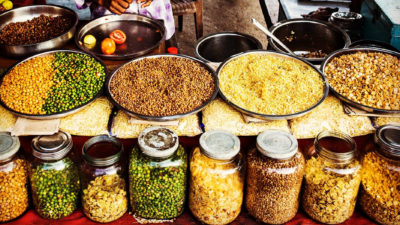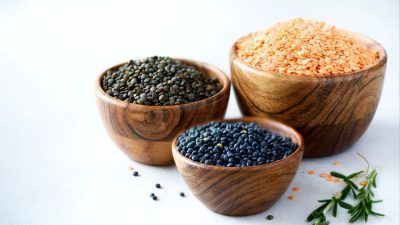Chickpeas

Chickpeas, also known as garbanzo beans, have been cultivated for millennia – at least for the last 8,000 years as far as we know. They come from the Middle East but their popularity saw them spread across the Mediterranean, North Africa and Indian subcontinent. As they are a very sustainable, nutritious and resilient crop, chickpeas are now grown worldwide, including in the UK.
Protein and mineral hero
One cup of chickpeas (160 grams) gives you an excellent protein dose – almost 12 grams! On average, men should eat 55 grams and women 45 grams of protein daily. It also provides 10 grams of fibre, healthy carbohydrates, about a fifth of your daily folate requirements and small amounts of B vitamins and vitamins E and K.
Chickpeas are also a mineral goldmine – one cup covers 10 per cent of your daily calcium, magnesium, iron and zinc requirements! It also offers a small dose of selenium, an important antioxidant.
No wonder people made it the star of many traditional meals, such as hummus, chana masala and falafel, and ground it into gram flour used to make farinata, poppadums, bhajis and pakoras.
Chickpea benefits
The combination of protein and fibre in chickpeas slows down your digestion, making you feel fuller for longer. At the same time, the complex carbohydrates provide heathy energy so you feel great and are less likely to overeat.
These qualities make chickpeas great for people with diabetes – they release their carbohydrate energy slowly, keeping blood sugar levels low. Preventing blood sugar spikes and dips is a key issue for diabetics.
Being a great source of fibre makes chickpeas excellent for your digestive health, feeding your friendly gut bacteria and reducing your risk of colon cancer. The fibre in chickpeas is also helpful in heart disease prevention and treatment. According to research, if you eat chickpeas regularly, it reduces the levels of fats and cholesterol in your blood, slashing your risk of high blood pressure and blood vessel narrowing (atherosclerosis).
When it comes to practicalities, buying tinned chickpeas is probably more practical for most of us. That’s why the nutritional values above refer to tinned chickpeas. However, if you use dried chickpeas and cook them at home, you get a higher iron, magnesium and zinc content. It’s worth batch cooking chickpeas if you have a big freezer – freeze what you don’t use for later.







